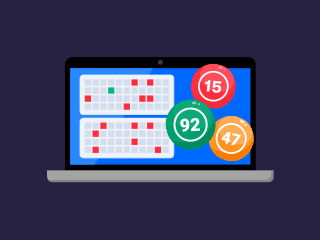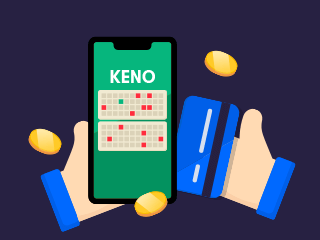Keno strategy: expert tips for winning at keno
Keno is simple, but there’s more to it than picking numbers. Many players think success comes down to luck. As someone who’s been playing keno for ages, I believe that understanding the game and knowing how to approach it can make all the difference.
In this guide, I’ll break down expert tips and actionable strategies for how to play keno and win (hopefully.) From bankroll management to selecting numbers in each keno variant, I’ll show you how to optimize your play and increase your odds.
Understanding how keno works
First things first, keno is pretty straightforward — you pick numbers, and the RNG (Random Number Generator) draws a set of winning numbers. In typical keno, you pick from 1 to 80, and a random draw of 20 numbers is made. To win, your chosen numbers must match the ones drawn.
The beauty of keno is that it’s simple. Here’s the thing though: even if it’s a game of chance, it operates under the guidance of an RNG. This, in turn, is tested and certified for fairness. That means that every draw is completely independent. If you hit a lucky streak, great! But don’t get bogged down by the idea that past results influence the next game.
Odds and payouts
The odds in keno depend on how many spots you play. The more numbers you choose, the lower your chances of matching all of them, but the payouts grow bigger. If you go for fewer numbers, your odds improve, but the payout is smaller.
Here’s a quick breakdown of the odds for various spot sizes:
- 1-spot: 1 in 4
- 4-spot: 1 in 1,000
- 7-spot: 1 in 40,980
- 10-spot: 1 in 8 million
Payouts can vary between casinos, but as a rule of thumb, you’ll see bigger payouts for matching more numbers. But remember, the risk of hitting those larger combinations increases the further you stretch your picks.
General strategies for playing keno

Selecting numbers
I’ve found that the way you select your numbers can actually help structure your game. Most people think numbers are purely random, and they are. However, different strategies can still help with managing your approach. For example, I like to spread my numbers across the card. This increases the chances of matching at least one number, even though it’s not going to pay off as big as a lucky hit. Spreading gives me more coverage, and it feels like I’ve got a better shot. Another popular keno strategy is clustering numbers—this means choosing numbers that are close together (like 1-10 or 11-20). While some players believe this gives a “lucky” advantage, the truth is, it doesn’t improve your odds. Still, if it’s your preference, it’s worth trying out.

Understanding payouts
Before I start any session, I always check the casino’s payout table to see how the payouts work. Some casinos offer higher payouts for fewer matched numbers, while others reward bigger matches with larger prizes. Always be aware of what you’re playing for—do you want more frequent small wins or fewer, bigger ones?

Bankroll management
I can’t stress this enough: Managing your bankroll is one of the most important parts of playing keno. When I start a session, I always set a budget––and stick to it. Once you’ve set your limit, it’s essential not to go overboard—especially when things aren’t going your way. A good method I use is dividing my bankroll into multiple smaller sessions. If I have $100 to play with, I’ll break it into 10 sessions of $10 each. That way, I can play a few rounds and still enjoy the game without burning through all my cash too quickly.
Advanced strategies for specific keno variants
Expert tips on patterns and approaches
1. Debunking the “Lucky Patterns” myth
I’ve seen plenty of players who swear by “lucky patterns” or “hot numbers”—but here’s the truth: there’s no such thing. The RNG ensures that every draw is random, so the numbers drawn last time have no bearing on what will happen next. So, no matter how many times people claim they’ve cracked the code, there are no predictable patterns.
2. Insights from experienced players
Experienced players will tell you that playing regularly with proper bankroll management is the real key. A lot of them also suggest playing multiple cards in one game, and I agree. By spreading out your numbers across several cards, you increase your chances of winning.
Pro tip: be careful not to overdo it. Staying within your budget is just as important as choosing the right keno strategy.
3. Using bonuses and free plays
In my experience, it’s never a bad idea to take advantage of bonuses or free play offers from online casinos. If you’re new to keno, free plays are a great way to try out different strategies without risking your money. Just be sure to check for wagering requirements or any restrictions that could limit your winnings.
Online keno vs live keno
Online keno is fast-paced, with quick rounds powered by RNGs. This means I can play several rounds in a short time, which works well if I’m looking for a quick, high-energy session. I tend to spread my numbers across the card, keeping it simple with fewer numbers and enjoying the faster draw. On the flip side, live keno takes its time, with each number being drawn slowly, which creates a more immersive and social atmosphere.
Here’s a couple of my personal strategy tips for online keno:
- Play fewer numbers for quicker rounds.
- Take advantage of free plays and bonuses to extend your session.
- Spread your numbers to cover a wider range without overloading the card.
Live keno offers a more relaxed experience where I can take my time between rounds. The slower pace makes it easier to reflect on my choices and stick to a specific strategy. I enjoy the social aspect and find I take bigger bets, like 8-spot or 10-spot games since I’m not rushed. The live element also lets me engage with other players and observe strategies in real-time.
For live keno I suggest:
- Take your time to select numbers carefully.
- Use the slower pace to track previous draws and adjust your strategy.
- Play fewer cards for more focus on each round.
Both versions have their perks. Adjust your approach based on the pace and the environment, and you’re good to go.
FAQs
What is the best strategy to win keno?
In my experience, the best strategy for keno is a balanced approach. First and foremost, managing your bankroll is key. I always set a budget before I start and stick to it, ensuring I don’t blow through my funds too quickly. When it comes to selecting numbers, I’ve found that choosing a moderate number of spots — like 4 or 7 — is often a sweet spot. It gives me a better chance to hit a few numbers without overloading the game and reducing my chances of matching all. Plus, spreading your numbers across the card gives you more coverage, allowing for more opportunities to win smaller prizes. Combining these elements helps me play longer and smarter without risking too much at once.
How does keno work?
Keno is a lottery-style game where you select numbers from a set range, typically 1 to 80. Once you’ve chosen your numbers, the casino’s RNG draws 20 winning numbers at random. Your goal is to match as many of your selected numbers to the drawn numbers as possible. The payout you receive depends on how many numbers you match, as well as the type of bet you placed. The more numbers you match, the higher your payout, but the odds of hitting those larger combinations decrease the more numbers you choose. It’s all about finding the right balance between risk and reward.
What are the best numbers to use for keno?
There isn’t a “best” set of numbers in keno. Since it’s a game of chance, the numbers are drawn randomly every time, and each number has an equal chance of being selected. However, some players like to bet on “hot” numbers—those that have been drawn frequently in recent rounds—while others prefer “cold” numbers, which haven’t appeared for a while, assuming they might be “due.” Personally, I like to mix it up and select a combination of both. This gives me more coverage across the board. Ultimately, it’s about playing in a way that feels comfortable for you, as there’s no proven method to predict which numbers will be drawn.
How to win 7-spot keno?
Winning at 7-spot keno can be tricky, but it’s all about selecting a mix of numbers. I’ve found that choosing seven numbers from different areas of the card—low (1-30), mid (31-60), and high (61-80)—is a smart approach. This spreads your bets across the full range of numbers and increases your chances of hitting a few correct ones. The key is to avoid clustering your numbers too closely together, as this limits your coverage. While the odds of hitting all seven numbers are low, this strategy gives you a balanced shot at hitting a few of them and maximizing your potential payout.



